October 13 - 19, 2013: Issue 132
John Black
 The great grandson of Albert Thomas Black – in charge of the Broken Bay -
Barrenjoey Customs Station (1868- 1890) still resides in Pittwater and
represents the fourth generation of Blacks to be associated with Pittwater.
Definitely a saltwater man with a love of the Australian Bush and sharing this
through the Chase
Alive Program, John Black's wide range of interests, including being a
member of the Manly-Warringah
Radio Society, personify 'active retiree'. He also allows us to glimpse not
only the heritage of Pittwater but Sydney for all those born to post WWII
scarcity who found life full and rich anyway. This very tall soft spoken
gentleman would not own to it, but the depth of his knowledge and range of
interests would exhaust a teenager.
The great grandson of Albert Thomas Black – in charge of the Broken Bay -
Barrenjoey Customs Station (1868- 1890) still resides in Pittwater and
represents the fourth generation of Blacks to be associated with Pittwater.
Definitely a saltwater man with a love of the Australian Bush and sharing this
through the Chase
Alive Program, John Black's wide range of interests, including being a
member of the Manly-Warringah
Radio Society, personify 'active retiree'. He also allows us to glimpse not
only the heritage of Pittwater but Sydney for all those born to post WWII
scarcity who found life full and rich anyway. This very tall soft spoken
gentleman would not own to it, but the depth of his knowledge and range of
interests would exhaust a teenager.
Where and when were you born?
I was born on the 17th of April, 1948 in Sydney in the Women’s Hospital in Paddington.
BLACK. - April 17, at Crown Street, to John and Margaret, of Killara - a son (John Duguld). Family Notices. (1948, April 19). The Sydney Morning Herald (NSW : 1842 - 1954), p. 10. Retrieved from http://nla.gov.au/nla.news-article18068275
Where did you grow up?
Mainly in Wahroonga. Wahroonga was almost rural then – there was a dairy down the end of the road, in Kintore street Wahroonga, the milk was delivered by horse and cart, I can remember that, as was bread originally. There was still properties there with horses agisted on them.
Right: John at Clareville Beach, circa 1950
What did you do for fun?
We used to ride around a lot on bicycles down the bush, there was a hell of a lot of bush in Wahroonga. I used to love going to the dump, which was just up the road, finding treasures. One of my best finds was a typewriter which I then taught myself to type on and has bow held me in wonderful stead for the computer age. Then I swapped it for a model aeroplane – so that was wonderful too.
Where did you go to school?
Barker College. I started off at Wahroonga Preparatory school which was a little church school near the park and then went on to Barker and did eleven years there.
What was Barker like?
I though I got a good academic education but I found it too rigid and too authoritarian, it really didn’t suit my personality. Too much emphasis on sport – I loved the cricket but I wasn’t a footballer, I was too tall and thin and injured my neck in a scrum at one stage so that was the end of my football career. I was quite happy to move out of that into tennis, which has been a wonderful sport for all of my life.
My parents were married in 1939, just before the war, and through the war mum never got pregnant and they decided she may never get pregnant and so bought a block of land down in Avalon, in Chisholm avenue. Dad got his mates with the Army to bulldoze a track onto there and he started building a shack there. They did get a house designed as they were going to live down there, which was very unusual for that time, he was going to commute to the city for work, but then mum got pregnant with me in 1947 and so they decided not to live down here.
He did build a shack on the block though so we’ve been coming down here ever since then for weekends and holidays. So my personal connection with Pittwater, apart from my ancestry, is very strong because of that link.
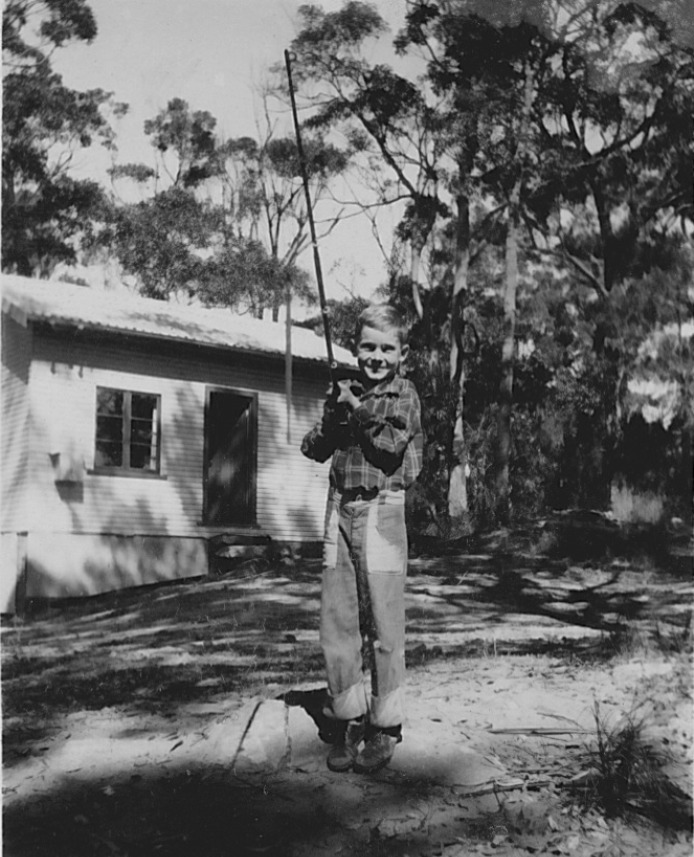
John at 4 Chisholm Avenue, Avalon, circa 1955. The shack is in the background.
So you were going to the beach?
Yes, going to the beach. Then when I was 14 I joined the Avalon Sailing Club in 1962, got a VJ and started sailing. It’s a great club, coming up for its 75th Anniversary next month too. My links with Pittwater are very strong – I have a strong affinity with this area. Avalon Sailing Club was all about the kids then – there was no adult sailing at all – and all in VJ’s.
What did you graduate to in sailing?
I went from VJ’s to a Flying Fifteen, which was a larger boat that was sailed at the Avalon Sailing Club – that was a two person boat which I sailed with my girlfriend, who is now my wife – we used to race there.
Where did you meet your wife?
I met her through a mate of mine who was doing Engineering who was taking her out. I was taking out another girl called Caroline and he ended up marrying her.
What was Avalon like then?
It was a much smaller shopping centre, this was before the Barefoot Boulevard was built. I can remember LeClerqs store. It was all bush up the Clareville end and shacks up where we were at Chisholm. There was a fellow called Colonel Reynolds where we were and he owned most of the ridge and mum bought our block of land from the Colonel back in 1945. it was wonderful – still koalas through the bush.
What did you want to do when you left school?
I did Mechanical Engineering and Computer Science at Sydney University, which was pretty new then. I think I was probably in the second year of Computer Sciences.
What were they teaching?
They taught Programming and basic computer design, so I did a lot of programming. They had the English Electric KDF9 which ran on paper tape. It filled a room, had operators – you couldn’t operate it yourself, you had to just hand your program in.
Is that the field you went into on graduation?
I went into computing. I did work as an Engineer for a number of years. I joined a research firm first called MD Research Company and we did research in fluid mechanics and mineral processing, which was fascinating. It was owned by a man called Charlie Warman – he started a company called Warman Pumps and made slurry pumps which became a very large international company and he sponsored the man who found t Newman iron ore, and the two of them ended up with a large amount of money from selling the rights to that and he then sold, as well, Warman Pumps and made a lot of money from that, and with the proceeds set up this research company called MD Research and still had Warman International.
He was a lovely man, very very nice man, he was investing back into Australia doing this. This company was based in Sydney – I was living in St Ives then, moved there in 1972.
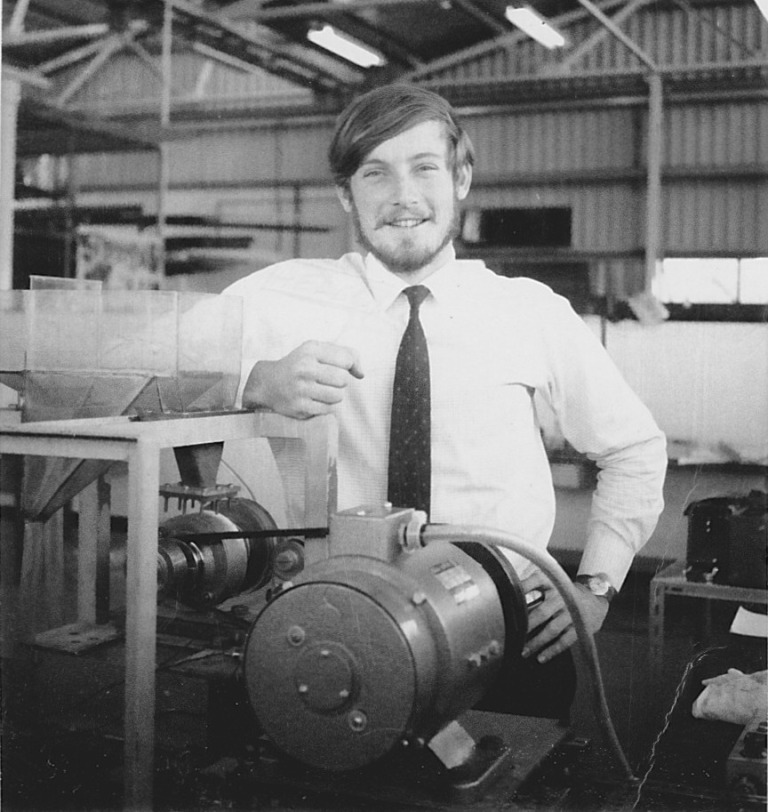
John Black at MD Research, 9.6.1970.
What did you go into after that?
I worked as a Production Manager of a furniture company for a while and then went overseas for eight months and did the great Australian crawl around Europe with my wife Frances.
What was your favourite experience of this trip?
We actually picked up a car for Fran’s father, a Mercedes. Back in those days, if you kept them in Europe for a certain period of time you could bring them back Duty and Sales Tax free.
One of our great experiences was driving this car across the Sahara Desert from Morocco – that was a bit of fun – there weren’t any roads, we had a Moroccan guide saying ‘turn left here’ and ‘turn right there’ and we were wondering, while in desert, ‘will we ever get out of here?’
Morocco was very interesting. I’ve recently been back there and it’s not quite as wild as it was.
When I came back there weren’t a lot of jobs for Engineers but there was a lot of work in IT. I joined Arthur Anderson in their IT Consulting Division and stayed in computing for the rest of my career.
If there were three threads that have been constant in your life, what would they be?
Saltwater and the sailing, activities.
Seeing the development of computers?
Yes.
You have seen this industry go from its formative years in Australia to what is available now- what are the biggest changes you’d cite?
I think computing has helped Australia overcome its isolation enormously because now we’re so much more linked to the rest of the world. Today you can buy something on ebay from the United States… The major shift here would be moving from the Main Frame to the mini which opened up computing for so many more businesses and made it accessible for smaller businesses and affordable. Then of course going from minis to the PC when they came along and made computing available to everybody. So those were the major huge shifts for computers themselves and then the introduction of the Internet on top of them was really the king of it all.
What were you introduced to as a history start for computers?
Back then it was Babbage who was cited as the originator of computers. He built the original computer engines which were mechanical devices to do calculations. His devices were programmable but he never finished them because he’d always start thinking of a better version.
You’re thinking of travelling to Antarctica at the end of this year – what is that all about?
While I was working at MD Research I went to the UNSW and did a Masters. I get their Alumni Magazine and in there was an article about Professor Chris Turney who was organising a Mawson Celebration Expedition, celebrating the centenary of Mawson’s great expedition in 1912-1913 to Antarctica.
I’ve always wanted to go to Antarctica and as a kid I loved reading about Antarctica – would read every book I could get hold of. So when I read this article I thought ‘this sounds just like me.’ When you join this expedition you do work – with the experiments and help get the measurements – because he’s going to repeat all the measurements that Mawson did. So you actually act as a field assistant to the various projects, which I think will be a terrific lot of fun.
You also work as a volunteer as part of the Chase Alive team, and conduct tours at Barrenjoey Lighthouse regularly. Is that because of your family connection with this place?
Yes, that really was the original impetus for me joining Chase Alive. I saw an advertisement for volunteers which also mentioned Barrenjoey and so joined. Originally I was doing some of the Walks and Talks that they run for people as at that stage I was still living at St Ives. These were in Ku Ring Gai and all of the National Parks in the north of Sydney up to the Hawkesbury.
Which was your favourite of these?
Muogamarra Nature Reserve has to be a favourite which is open only during the Wildflower season, only six weekends a year – that’s an absolutely beautiful place. Normally I would help each year in Muogamarra even though I’m doing Barrenjoey.
The Great North Walk was also a favourite – which goes from the city all the way up to Gosford.
They all have a historical aspect as well as sharing information about the environments. The guides who take these walks always read up and learn about what’s along each track – it’s vital to learn all that before you can share it with the people who come along.
When you’re up at Barrenjoey, do you see your great grandfather out the corner of your eye?
Yes, I do.
What’s he doing – wagging his finger at you or applauding, saying ‘well done son’?
(Laughs) I hope so.
Do you get a sense of what he may have experienced while there?
I think you do. I think Barrenjoey and even Pittwater itself is still very much the way it was back in the 1800’s or even when Phillip (First Fleet - Governor of NSW) first came in here. You can sail in here and you still see all the bush and the landscape, the houses are hidden behind the trees, and that is one of the wonderful things about the whole environment here.
My father’s father was born at Barrenjoey, my grandfather.
All the children of Albert Thomas Black and Kate Margaret Black (nee Mulligan) were born at Barrenjoey: John (1869), Ada (1871), Albert (1872), Reginald( 1874), Mabel (1875), Norman (1877). Reginald Austin William Black is John's grandfather and father of Reginald John Black, John's father.
Did you ever get to talk to him about life on Barrenjoey?
No, he died before then. He became a Mining Engineer and moved to Kalgoorlie before the First World War and that’s where my father was born in 1904. So having grown up in Pittwater and the bush and the sand he moved to Kalgoorlie and the desert basically.
Funnily enough I‘ll be visiting Kalgoorlie for the first time later this week – on the Indian Pacific to Perth.
You’re having a great time in retirement aren’t you?
Life’s not too bad. You’ve just to get to retirement time and then you too will have a great time.
What’s the best thing about being up at Barrenjoey Lighthouse - Do people make the connection between you and the lightstation’s heritage?
Sometimes I share the family history and sometimes I don’t – it depends on the group and where the conversation goes. It is nice to share that with some people.
When did you move to Pittwater permanently?
2005. We decided to retire down here. I originally had a little block of land in Church Point and was going to build a house there but then I decided we’d live at Newport.
Are you still sailing?
Yes, I sail a lot. Now we share with two other families a Dufour 425 – we go in Twilight sailing, all around Pittwater. We’ve taken it up to the Whitsunday’s and we like going up to Broughton Island north of Port Stephens.
So you’re a saltwater man too?
Definitely. My son bought a yacht too in Germany in the middle of last year and sailed it out here – I sailed with him for about four months and did about 6000 miles. It was a big adventure.
What’s the best thing about sailing?
I think the nice thing about sailing is you’re just out there with Nature and you’ve got to focus on the sailing and everything else goes out of your head. I think that’s a lovely part about it – I think you can just forget about the rest of the world for a while ad just give yourself over to the whole experience.
Do you think this closeness to saltwater is something that can be in the blood?
Yes, I think it is. There’s has been a lot of it in our family. My original ancestor came out here in 1798 … (Captain John Black)
Have you investigated much about him?
Yes, I’ve read a lot from him as he wrote letters back to his father. He speaks a lot of the experiences and adventures he had on one voyage. He embarked on a convict ship called the ‘Lady Shore’ which left England in 1797, he was only 19. They had a cargo of female convicts on board and were guarded by a platoon of British Marines. Off the coast of Brazil the Marines mutinied, killed the Captain and took over the ship, and they put the officers and passengers in a longboat and my ancestor at the age of 19, then sailed this longboat to the coast of Brazil and successfully got ashore despite the mutineers expecting them to be lost at sea. He then had various adventure travelling along the coast of Brazil, and ended up at St Catherine island where he shipped aboard another vessel called The ‘Indispensable’ which had letters of marque and was out hunting Spanish ships. Britain was at war with Spain at the time.
They captured a Spanish ship (La Union)and he was the only other person who could navigate so he was put in charge of that ship and it was then sold and with the proceeds from that he then invested in Port Jackson, sailing out here and establishing himself here.
Does it amaze you that men so young were doing such amazing things then?
Oh yes, it does. They had so much responsibility at such a young age and going into the wilderness, the unknown. The young people of then would have had to be far more mature and independent. But I think it’s also the way we treat our young people – we’re so risk adverse today, we’re terrified this or that is gong to happen and so we keep our children young and we shouldn’t. And they want to have excitement and adventure – I think that’s why so many young people chase these extreme sports nowadays, because they’re looking for that outlet they’re not finding in normal life because they’re too molly coddled.
FitzRoy was only 28 when he Captained The Beagle, Darwin was only 28 – they did all these things before their 30’s.
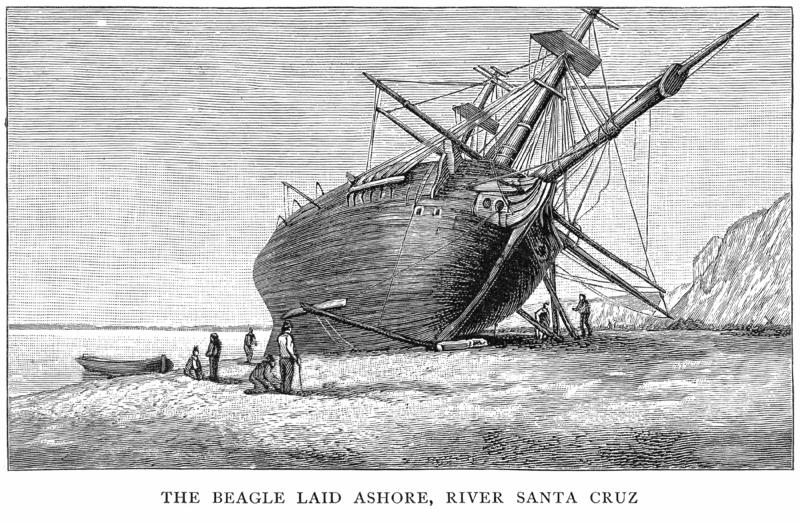
The Beagle Laid Ashore for repairs. Location: Tierra del Fuego, Santa Cruz river, 50.1125°S and 68.3917°W; 16 April 1834, Francis Darwin, Life and Letters of Charles Darwin, p. 160, 1888.
So you have a long connection with the sea through your family?
Yes, a long seafaring connection.
Have you started putting this together so people may access it?
A distant relative has put quite a lot of it up on the web. What I was keen to do was to get a film or documentary done of my ancestor's adventures but the feedback I got was that those type of productions are so expensive and impossible to get the money together.
I do have a good photographic record of Barrenjoey and those times, and stories from my aunt Mabel who lived there and used to row down Pittwater at the age of 12 and pick people up from Mona Vale or Newport.
You have retired now – what’s the best thing about being retired?
The flexibility of having the time to travel, to do the things you want to, to be able to pursue things that you would have liked to pursue at other times. I’m still looking forward to the day when I wake up and say 'I’ve got nothing to do today’ but I don’t think that will ever happen.
You may be a bit bored if that day ever occurs.
Yes.
What is your favourite place/s in Pittwater and why?
Coasters Retreat has to be a favourite, it’s lovely, especially sailing there mid week and find it deserted – to swim across The Basin and back or have a walk up into the bush.
Jerusalem Bay I love. West Head, all those walks through there. Maitland Bay – we love going to Maitland Bay – we like going hiking in the Bouddi National Park.
So you’re still very active?
Oh yes, I like being active.
What is your ‘motto for life’ or a favourite phrase you try to live by?
Take opportunities as they come – I don’t think you want to plan your life too much. I think I’ve followed that and my wife has followed that – we didn’t worry about planning a career – everything falls into place – you see that as you get older – you see the opportunities as they come up and seize that.
I think making sure throughout your life that you do have enough recreation time is very important. We’ve always ensured throughout our lives that we do have time off, recreation, and travel.
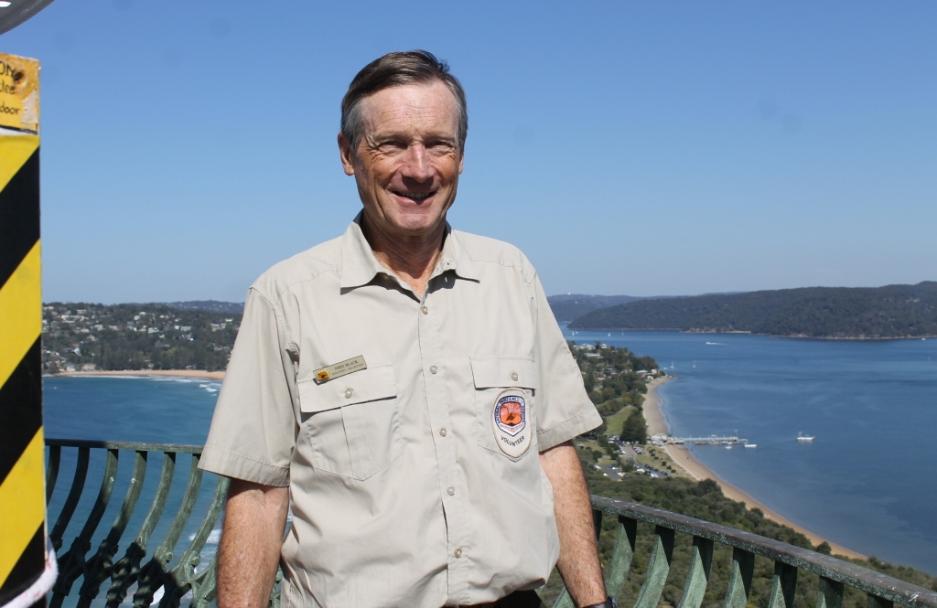
John Black at Barrenjoey Lighthouse during International Lighthouse Lightship Weekend- 2013 at Barrenjoey. Picture by A J Guesdon.
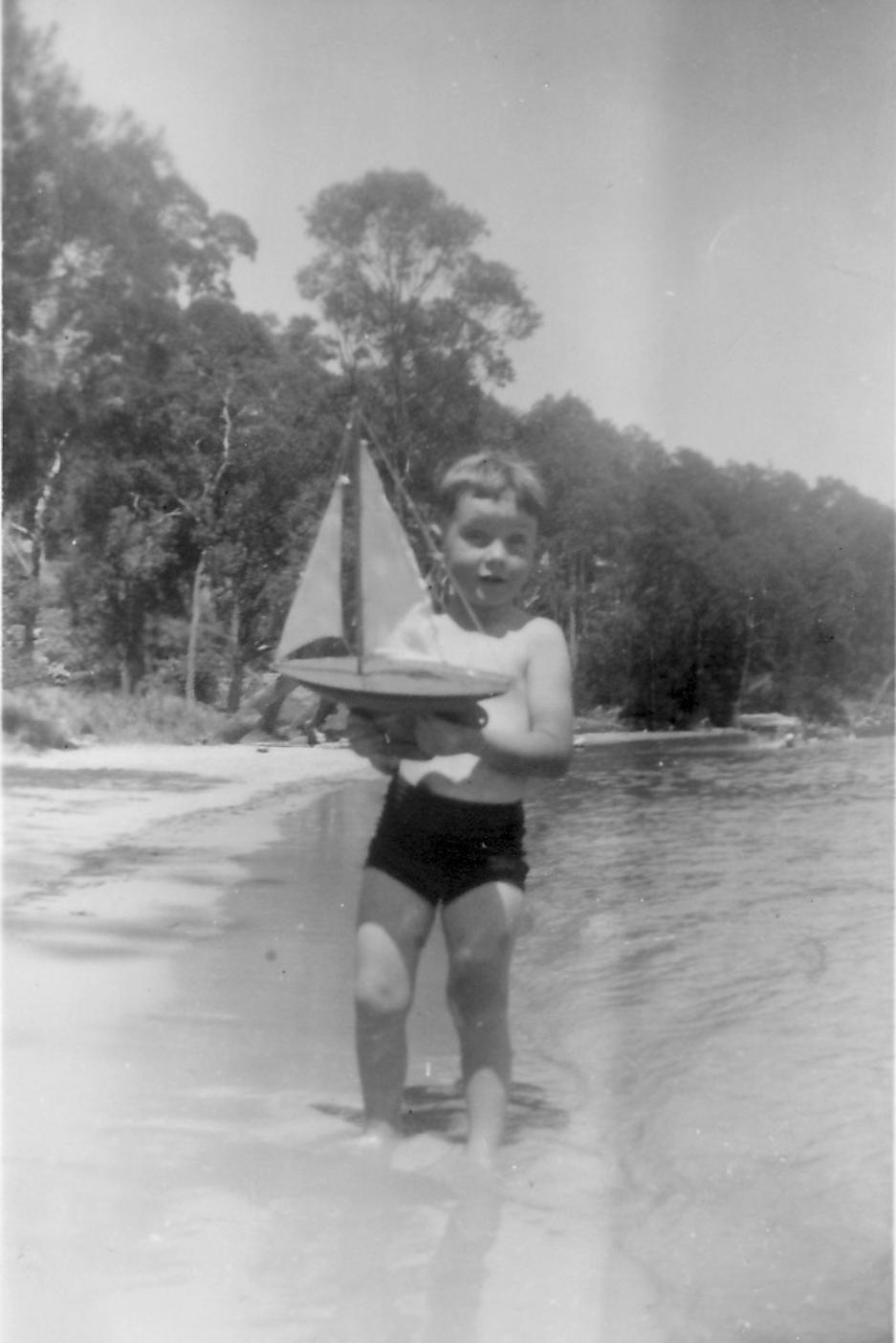
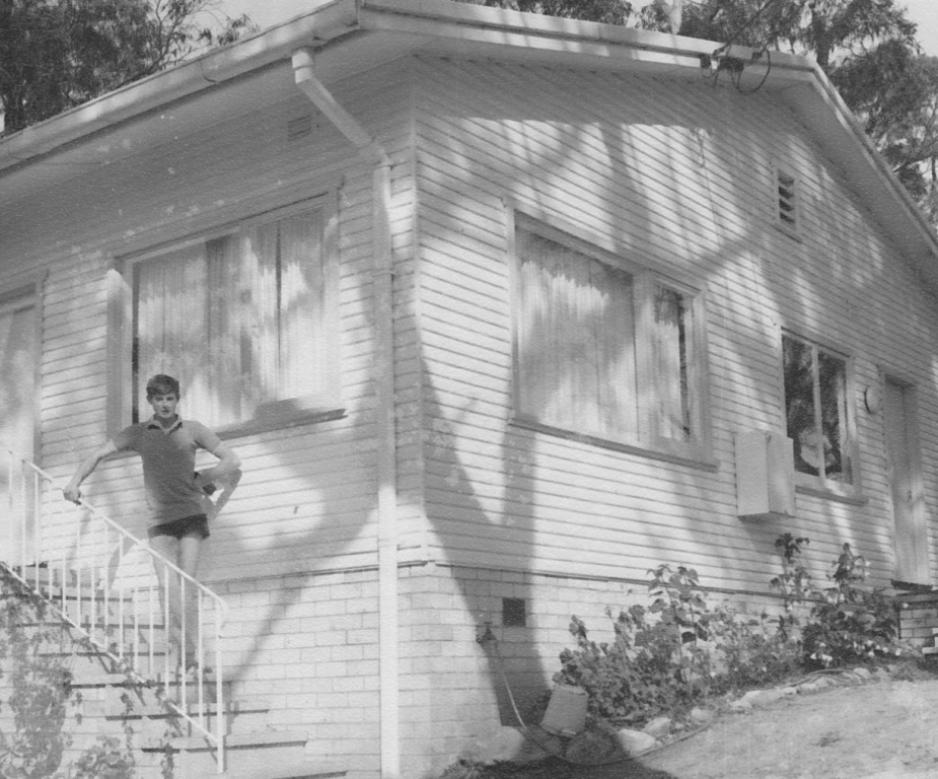
John at 4 Chisholm Avenue, Avalon, May 1965.
Copyright John Black, 2013.